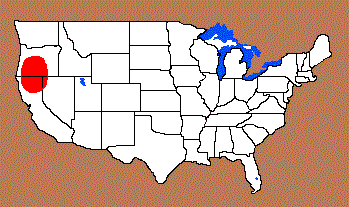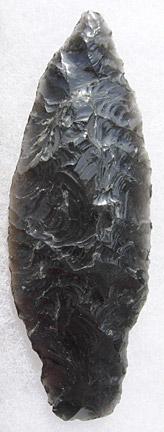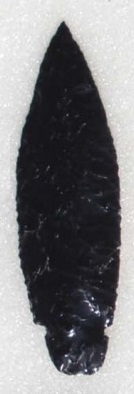Name Details:
Named By: Carrol B. Howe
Named For: Type Site Area
Date Identified: 1979
Type Site: Nightfire Island Site (4SK4), Lower Klamath Valley, Siskiyou County, Oregon
Nightfire
(Collector Type)
Cluster:
Commonly Utilized Material:
Date:
Cultural Period:
3,500 - 1,400 B.P.
Late to Transitional Archaic
Neoglacial to Roman Warm
Glacial Period:
Culture:
Outline is Representative of Size and Shape:
Description of Physical Characteristics and Flaking Pattern:
This is a medium to large triangular to lanceolate shaped point with an elliptical cross section. The blade is excurvate with many
examples having the tip curve in and curving back in towards the shoulders. Parallel notches enter higher on the blade leaving a large basal area. The stem is contracting. The base is commonly straight, but may range from slightly convex to slightly concave. The
flaking pattern may vary from random to horizontal and is generally well made.
Size Measurements: Total Length - 38 to 67 mm,
Stem Length - 14 to 21 mm, Blade Width - 12 to 29 mm, Neck
Width - 10 to 17 mm, Stem Width - 13 to 19 mm, Thickness - 5 to 10 mm
Distribution:
Distribution Comments:
These points are primarily found in the Klamath and Surprise Valley's of Oregon. This point may be found into central Oregon, Northern California (Shasta Valley) and northwestern Idaho.

Additional Comments:
These points were fist identified in the lower Klamath Valley and Surprise Valley in Oregon. At the Nightfire Site these points were identified as Northern, Elko, or Cascade type points. There were no mention of
Nightfire Projectile Points in any of the reports or any subsequent publications discussing the Nightfire site. Please see the link below for a detailed discussion on projectile points found at the Nightfire
site (page 299). There are examples shown that fit into the Nightfire description, but they list them in this report as Elko Round Base variants (Sampson, 1985). Nisbitt (1981) describes points from the
Nightfire site as "Cascade like" stemmed points.
Collectors sources list this type as a Northern variant (middle Archaic), but Northern type points are noted for the concave base which are missing in these points. They more closely represent a Elko type point
which is the levels they were located in at the Nightfire Island site. These points are similar to the Sudden type points found in the Great Basin. However, this type has a contracting stem where the Sudden
type has a straight stem. Larger examples shown in collectors sources have similar appearance to the Need Lanceolate. This type may represent an extension of distribution of the Need Lanceolate. The
smaller examples shown in collectors sources have a similar appearance of round base Elko type points described in the link below.
Other points in this Cluster:
Point Validity: Collector Type
Howe was a avocational archaeologist and a resident of Klamath Valley and an educator at the local school district. He became principle and then superintendent. He was interested in local archaeology and wrote many publications
regarding archaeology of the Klamath Valley. He named this point in a publication, but there has been no professional references to this type (see Additional Comments). This type has many collector source
references. This type is considered a collector type.
.
Age Details:
References: (See Reference Page, Entry Number):
23, 30
Nightfire Projectile Point, Nightfire Arrowhead




